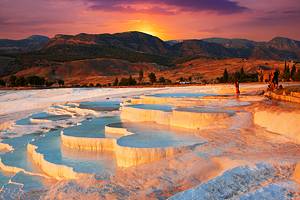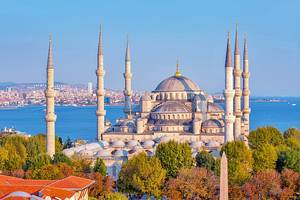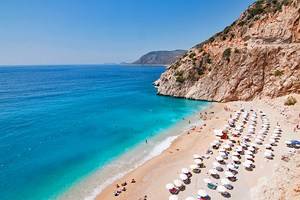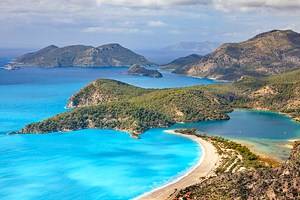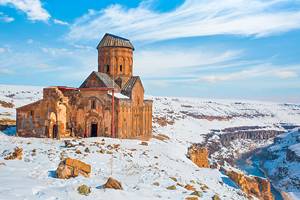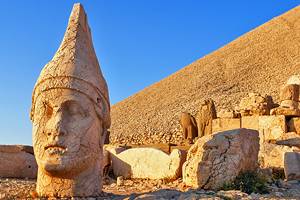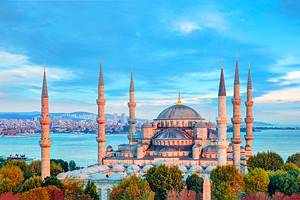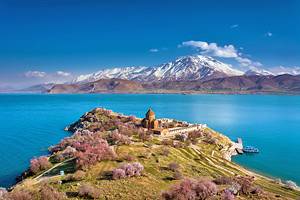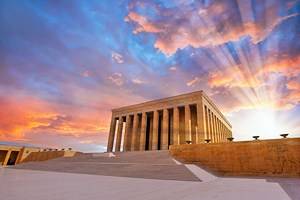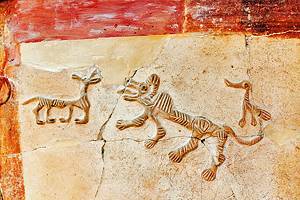Cities in Turkey
Author Jess Lee has been writing about traveling in Turkey's cities for guidebooks and magazines for a decade and lives in Turkey.
Turkey's cities are where you experience Turkish life at its most vibrant. Many of Turkey's cities, even those known today as modern centers of business and industry, have ancient roots, and hold on to old town districts replete with the fine architecture from older eras, whether Ottoman, Byzantine, or Classical.

If you want to explore the grand building works of empires past, seek out some of the country's best dining, or simply get lost within the bazaar bustle, make sure to add some city time into your travels.
Plan where to find the big-city scene with our list of the best cities in Turkey
Istanbul
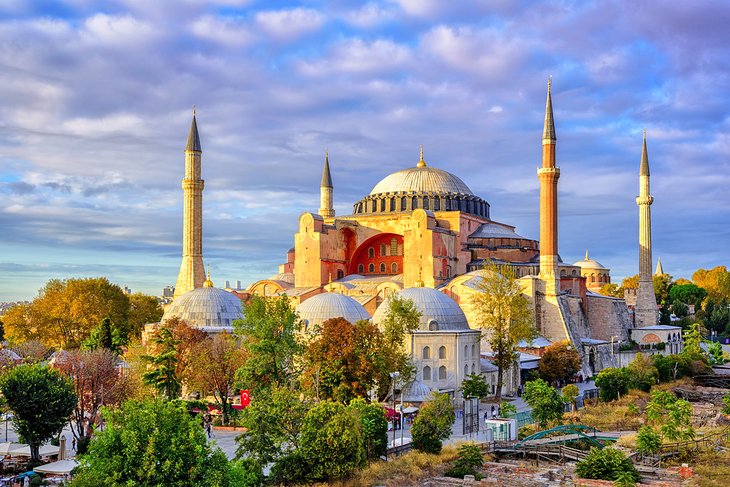
Highlights: One of the world's great metropolises, mixing grand Byzantine and Ottoman heritage with vivacious, contemporary dining; entertainment; and street life
Istanbul manages to merge its vast ancient past and hectic modern mega-city buzz with an aplomb not managed by many other cities. This is Turkey's major metropolis. Straddling opposing shores of Europe and Asia, it is home to a population of about 15 million.
Unsurprisingly, Istanbul is one of the world's favorite city-break destinations. There are few other cities on Earth where you can visit this mind-boggling multitude of historic monuments from different eras.
Just in its central old town core, it holds more world-class tourist attractions than some entire countries can count.
You could spend weeks here and still find new things to see and interesting places to shop, but for first-time visitors, the historic center is where to concentrate your time. Here, you'll find the city's most famous grand Imperial building projects from both the Byzantine and Ottoman Empires.
The Blue Mosque, Hagia Sophia (Aya Sofya), Topkapı Palace, and the Grand Bazaar are the big four.
Beyond these, though, there are Byzantine cisterns, more multi-domed and lavishly tiled mosques, Baroque palace architecture, and frescoed churches to discover. And history is only part of Istanbul's charm.
Don't be lulled into thinking this city is just the sum of its grand past. Street life here has a buzzing, youthful vibe, while some of the best ways to soak up Istanbul's atmosphere — taking to the Bosphorus Strait for skyline vistas or experiencing a traditional Turkish bath in an ancient, domed hamam — are some of the most easygoing sightseeing options you can get.
The café and dining scene includes everything from reworked Ottoman palace dishes and regional specialties to modern Mediterranean and fusion flavors. And with big players such as the Istanbul Modern (scheduled to reopen inside the new Galata Port development) and ARTER, the contemporary art scene is thriving.
Read More:
Antalya
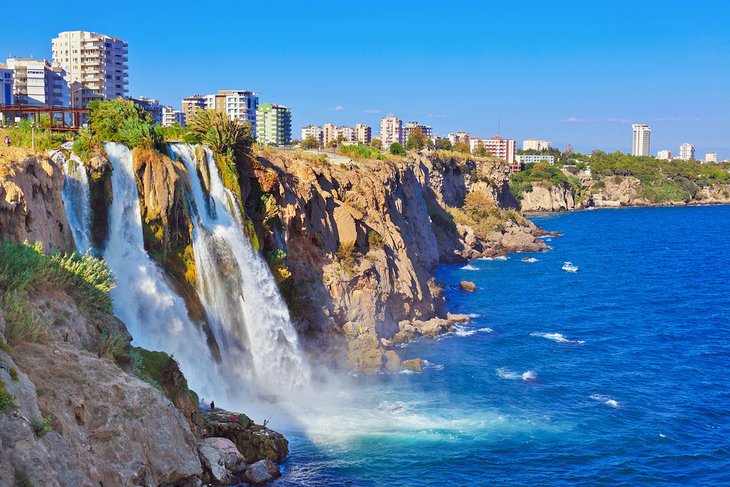
Highlights: Beach life with big-city facilities, dining, and entertainment on tap, plus a quaint old town district at its core
Turkey's premier Mediterranean resort is also an important center of commerce with a population of 1.2 million, so there is plenty of cosmopolitan buzz to add to its beach life.
Antalya is one of the best places to visit in Turkey if you want to combine sun and sand with city amenities on hand.
Laid-back beach life is found at both Konyaaltı beach and Lara beach, but the city's vibrant and varied café and restaurant scene is still easily on tap.
With the Kaleiçi district at Antalya's core, you have one of Turkey's best-preserved old towns within easy reach for days when it's time to do more than top up your tan.
This neighborhood of Ottoman-period mansions leading down to a Roman-era harbor, with views that swoop across the jagged, mountainous coastline, provides enough tourist attractions in itself even if you're not interested in having the beach on hand.
If the sights within the city aren't enough, Antalya also sits on the doorstep of a whole swag of Turkey's major archaeological sites.
With the famed Classical-era ruins of Aspendos, Perge, Side, and Termessos just day trip hops from town, you'd be hard-pressed to find a beach town with more to offer.
Read More: From Istanbul to Antalya: Way to Get There
Bursa

Highlights: Hub of Ottoman culture, silk road heritage, and winter ski destination
The original capital of the Ottoman Empire, Bursa today is a vast, rambling, modern city, home to two million.
Most visitors will want to concentrate their sightseeing in the city's central districts. The 20-domed Grand Mosque, exuberantly tiled interiors of both the Yeşil Mosque and tomb, and the colorfully decorated mausoleums of the first Ottoman Sultans within the Muradiye Complex are the most famous monuments from Bursa's imperial reign.
At the city's core is the massive Covered Market, where multiple hans (caravanserais) and bedestens (warehouses) showcase Bursa's heritage as a Silk Route trading point. Don't miss the Koza Han with its numerous silk shops still continuing the tradition.
For some travelers though, all this heritage on display is secondary.
Foodies are here to dine on Iskender kebab in the city where it was invented. Nearly every restaurant in town offers this up as their headline dish but for the real deal, beeline to Kebapçi Iskender where it was first created.
During winter, Bursa is the base city for the popular ski resort on Uludağ (Grand Mountain) and the Bursa Teleferik, which is one of the longest cable cars in the world and the most scenic way to head to the slopes.
Read More: Attractions & Things to Do in Bursa
Şanlıurfa
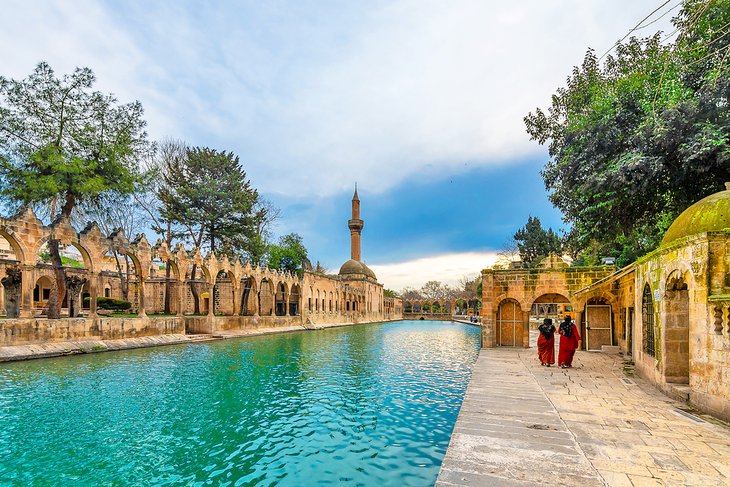
Highlights: Ancient holy pilgrimage city with some of the world's most important Neolithic sites on its doorstep
Due to the ongoing aid response in the aftermath of Turkey's February 2023 earthquake, you should check the latest governmental travel advice before traveling to the Şanlıurfa region.
Claimed birthplace of the Prophet Abraham and once the Byzantine city of Edessa, Şanlıurfa has always been one of the most interesting stops in Turkey's southeast.
In the last few years, as the archaeological site of Göbeklitepe has been opened up to tourism, a new wave of visitors have also flocked here. These Neolithic monoliths, sitting just on the city outskirts, were anointed with UNESCO World Heritage status in 2019.
In the city center itself, a massive and thoroughly contemporary new Archaeological Museum provides one of Turkey's most fascinating museum experiences, thoroughly complementing the site by devoting a large swath of its space to exhibits from both Göbeklitepe and the Şanlıurfa region's importance in early human history.
Even without these two recent major tourist attractions though, Şanlıurfa has plenty for visitors to unpack.
The old town district's bazaar is a busy muddle, where traditional craft workshops and market produce stalls huddle amid skinny alleys and where the courtyards of old caravanserais are now put to use as atmospheric open-air cafés.
Leading out from the old town district, at the city's very heart, is leafy Gölbaşı park. This major pilgrimage area plays center stage in the city's local lore, with historic mosques built on sites important to the story of Abraham, and fish ponds filled with sacred carp.
Izmir

Highlight: Vibrant, modern city-slicker life and jumping-off point for some of the Aegean's most famous ruins
This provincial capital, and Turkey's third biggest center, with a population of 2.9 million, is a big-city base for the nearby sites of Ephesus and Pergamum, which are both day-tripping distance.
Spreading along the Aegean waterfront, Izmir today is feted as one of Turkey's most lively metropolitan centers. Its youthful, commercial buzz and modern façade hides a vast history.
Izmir was once Smyrna, the most important port town along this coastline from the Roman period up to the end of the Ottoman era.
Along with Alexandria in Egypt, it was feted for centuries as a Mediterranean cosmopolitan hub, where Turks, Greeks, Jews, and Armenians all thrived.
A catastrophic fire at the end of the Turkish War for Independence in 1922 wiped out much of Izmir's historic neighborhoods, but a glimpse of its storied past can still be found in the vast Kemeraltı Market district snug in the city core. Here, Ottoman warehouses now house craft workshops, caravanserais are converted to coffee houses, and alleyway stalls are piled high with produce and household goods.
Read More: From Istanbul to Izmir: Ways to Get There
Konya

Highlights: Historic spiritual center, Seljuk era heritage, and Mevlevi pilgrimage site
The ornately tiled Mevlana Museum, home to the tomb of 13th-century Sufi poet and preacher Mevlana Celaleddin Rumi, has made this old Seljuk capital a major stop for any traveler heading east from the Mediterranean coast.
Most visitors time their trip to watch a performance by the whirling dervishes (twice weekly in summer; once a week the rest of year) in the birthplace of this Mevlevi Sufi sect.
Konya's Sufi connection has made its tourism name but there are plenty of attractions beyond the dervishes.
The central city is crammed with the surviving mosques and monuments from Konya's grand era as Seljuk capital in the 13th century. Some, such as the Karatay Medresesi, have been painstakingly restored and turned into interesting museums that highlight the artistic accomplishments of the Seljuk era.
Outside the city itself, the stark surrounding plains are home to a host of attractions that will convince history-minded travelers to linger another night in town.
Top of the list is the settlement mound of Çatalhöyük, where archaeologists unearthed one of the world's largest Neolithic villages.
Fethiye
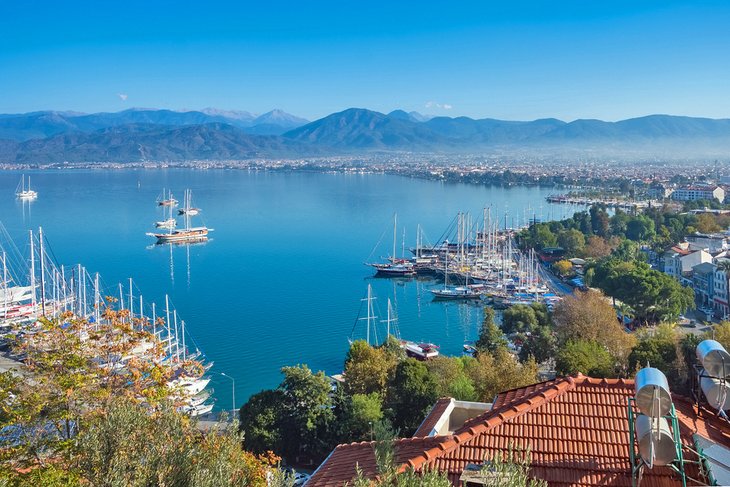
Highlights: Mediterranean harbor town and major jumping-off point for yachting trips
With its spectacular harborfront setting, this small city of 100,000 is one of Turkey's most popular places to visit along the Mediterranean coast.
Fethiye is a major yachting destination. There are bundles of sailing activities on offer, from daily group boat tours to multi-day private yacht hire.
The harbor here is also the departure point for Turkey's most famous sailing itinerary: the three-night Blue Cruise, which takes in some of the best coastal panoramas along this stretch of coast.
Although Fethiye is primarily all about the water, its location is also perfect for launching out to explore the vast amount of ruins hidden in the surrounding lush forested hills.
The Classical-era Lycian ruins of UNESCO World Heritage-listed Xanthos and Letoön are just two of the major archaeological sites within day-tripping distance.
If, though, you are simply focused on sun and sea, this is the nearest city base for the famed beaches of Ölüdeniz, with its paragliding and boat trips, and Butterfly Valley.
- Read More: Attractions & Things to Do in Fethiye
Gaziantep

Highlights: Foodie hub, craft center, and old town heritage, plus one of the world's most renowned mosaic collections
Due to the ongoing aid response in the aftermath of Turkey's February 2023 earthquake, you should check the latest governmental travel advice before traveling to the Gaziantep region.
Turkey's baklava center needs no introduction to foodie travelers. Gaziantep's sweet treats are famed throughout the country. There's plenty to discover beyond the sugar-hit though.
One of the prime tourist attractions is the Gaziantep Zeugma Mosaic Museum.
Highly contemporary and beautifully conceived, the museum holds one of the world's most important collections of Roman period mosaic floor art, all rescued from the nearby Belkis-Zeugma archaeological site before it was submerged under the waters of the Birecik Dam.
One of the real pleasures of Gaziantep is wandering the old town area. Its multitude of baklava shops and compact bazaar alleys, stuffed full of traditional craftwork stores and historic coffee houses, could consume a full day of your time.
Ankara

Highlight: Turkey's most important museum and the modern heart of the country
Turkey's capital, and the second biggest city in the country, with a population of five million, is slap in the center of the country.
Ankara is a sprawling center of business and industry often dismissed as a modern city, but there are three big reasons to add it into your Turkey tour.
Beeline here to visit the excellent Museum of Anatolian Civilizations, which holds an unparalleled collection of artifacts from archaeological sites across the country. Exhibits range from the Neolithic through to the Iron Age. If you want to understand the vast breadth of Turkey's ancient history, this is the best place in the country.
Although the city only rose to prominence during the modern era, Ankara has ancient roots. Its hilltop citadel district, sitting within the shattered remnants of Byzantine walls, is the best place to experience some of that heritage.
Ankara's other major attraction, and a modern pilgrimage site, is the Anıtkabir. This hilltop complex holds the mausoleum of Atatürk, the founder of modern Turkey. Come here to understand how this modern nation was forged in the years after World War I.
Ankara is also the nearest base to the ruins of the Hittite capital of Hattuşa, the Bronze Age Empire, which once ruled over much of Anatolia, and the Iron Age site of Gordion, where Alexander the Great cut the Gordion knot.
Eskişehir
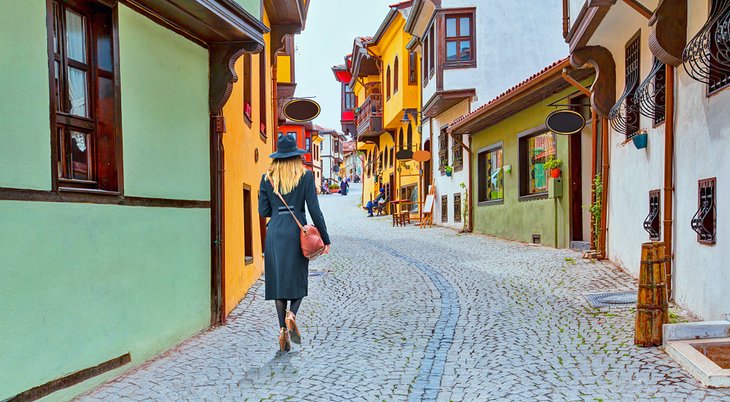
Highlight: Contemporary art hub, youthful buzz, and a lively cafe scene
This major university center is all about café culture, gardens, and art.
Full of youthful energy and buzz, Eskişehir is a big hit with local families who day trip here on summer weekends for gondola rides on the river, picnicking in the parks, and strolling the small old town district of Odunpazarı.
Odunpazarı is also where you'll find Eskişehir's newest attraction. The OMM (Odunpazarı Modern Museum) art gallery holds a permanent collection of modern art, comprising sculpture and installations as well as paintings, and hosts temporary exhibitions of big names in the contemporary art scene. It's the most important private art gallery outside of Istanbul.
Eskişehir used to be bypassed by many travelers, but the new high-speed train lines connecting Istanbul with Ankara and Konya have made Eskişehir (a station on both lines) a popular stop-off for travelers heading inland.
Van

Highlights: Lake Van, Armenian artistry and heritage, and ancient Urartian treasures
Way out in Turkey's southeast, the city of Van sits beside Lake Van's shore and is a major transit point for travelers before or after crossing into Iran.
Due to a series of earthquakes that struck in 2011, and leveled much of the central city, Van's architecture is thoroughly modern. This disguises the ancient, cosmopolitan history of this area, which during the Ottoman era had a large mixed population of Armenians, Turks, Kurds, Syriac Christians, and Yezidis.
Head to the city's edge, near Lake Van's shore, to explore the fragments of Eski Van (Old Van). This was destroyed when Van became first a front line for fighting between Ottoman and Russian forces during World War I, and then again in the Turkish War for Independence after Allied forces handed Van to Armenia.
Afterward, hike up to ancient Van Castle for panoramic views across town and the surrounding countryside, and then delve into this region's deep past at Van Museum with its globally important collection of Urartian artifacts.
The big highlight of a visit here, though, is a trip to Akdamar Island on Lake Van to visit Akdamar Kilisesi (the Armenian Church of the Holy Cross) with its facade of carved Biblical scenes. This is one of Turkey's most important historical religious sites and one of the greatest artistic treasures of the medieval Armenian kingdoms.
It's not all about history and architecture, though. Van is also a major foodie haunt, renowned for its distinctive food culture and famous for its Turkish breakfast spreads.
Trabzon
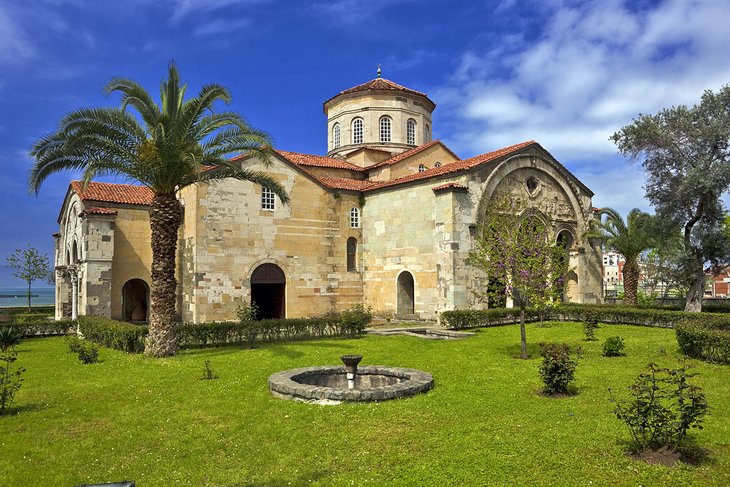
Highlights: Lively Black Sea port city with a historic core, plus the prime base for trips to Sumela Monastery
This is the Black Sea coast's most tourist-oriented city.
Most visitors usually spend just one night before launching themselves out on trips into Turkey's lush tea-growing hills or to visit Sumela Monastery, one of the Black Sea's most famous sights. Though the monastery has been closed for restoration for the past several years, just viewing its location, built high up in jagged cliffs, still makes it a major attraction.
Trabzon is worth more time than most travelers give it, though. In the city itself, the major tourist sight is the Aya Sofya, a church-turned-mosque that holds important 13th-century frescoes.
After visiting the Aya Sofya, dive into the central bazaar district and the fortified Ortahisar (middle castle) neighborhood. Both have held on to plenty of Ottoman architecture, with several caravanserais now used as cafés and shop space.
Trabzon is also one of the Black Sea's best destinations for sampling Black Sea cuisine. Plenty of restaurants in the city center specialize in the distinct dishes of this region, showcasing the fusion of Georgian, Greek, and Turkish flavors that hark back to the Black Sea's multicultural past.
Edirne

Highlights: Sinan's greatest mosque and Ottoman heritage within Turkey's tiny slice of Europe
Nudging up against the borders with both Bulgaria and Greece, Edirne is the major city of Thrace (the tiny corner of northwest Turkey that sits within Europe).
Once the Roman city of Adrianople and later capital of the Ottoman Empire (Mehmet II launched his conquest of Constantinople from here), Edirne has a long and grand history that can be glimpsed in the preserved imperial architecture that still dots its central city.
The major tourist attraction in town is Edirne's Selimiye Mosque, regarded as the finest example of mosque architecture built by the famed Ottoman architect Sinan.
Any visitor interested in history, though, will find plenty of other things to do in Edirne, with a glut of other mosques and Ottoman-era monuments to explore.
Edirne's location makes it a convenient stop on the overland route between Istanbul and Bulgaria or northern Greece.
Amasya
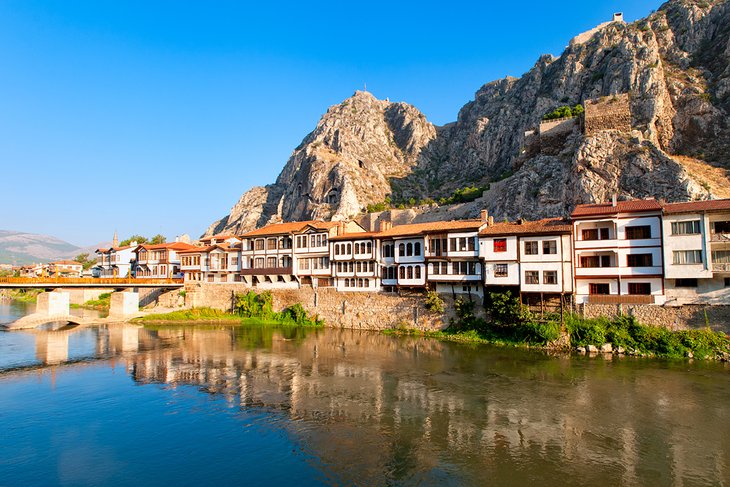
Highlight: Riverside strolls below Pontic remnants in one of Turkey's prettiest small cities
Amasya sits squeezed between high cliffs, with the Yeşilirmak River winding through its center.
Although a laid-back, small city today, Amasya was once capital of the Kingdom of Pontus and later, during the city's Roman era, it was the birthplace of Strabo, the famed Roman geographer.
There may be few big tourist attractions or major things to do within town, but Amasya makes up for that fact by providing plenty of ambience and opportunities to soak up the views.
Stroll the riverfront where a clutch of preserved Ottoman wooden mansions line the northern bank, with the tombs of Pontic kings cut into the looming cliff above, and then head up to the scant remains of the castle, perched on the cliff summit for vistas across the valley.
In the central city itself, don't miss visiting the 15th-century Sultan Beyazıt II Mosque with an interior that rivals Istanbul's imperial mosques for grandeur.
Kars
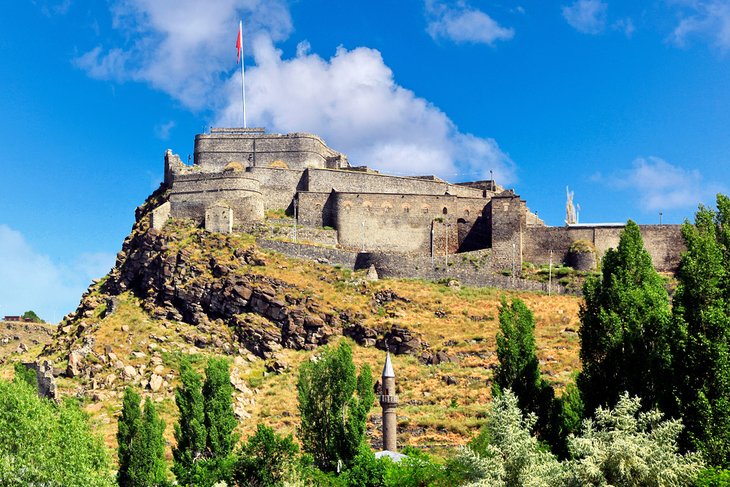
Highlight: A handful of heritage buildings in the city core and a base for day trips to Ani
The major city of Turkey's far northeast, Kars is the nearest base to the ruins of the Armenian Kingdom capital of Ani, one of Turkey's UNESCO World Heritage sites.
Nearly every traveler heading to the archaeological site will spend at least one night here.
Kars itself has a very individual style compared to other Turkish cities, mostly due to the town's era under Russian occupation from 1878 to 1920, which gave Kars its distinctive stone-cut mansion architecture and grid-like road layout.
The city's northern corner is home to a handful of historic buildings. Head first to the Kümbet Mosque, which was originally the 10th-century Armenian Church of the Apostles, and then hike up to Kars Castle for the views across the town and surrounding stark countryside.



